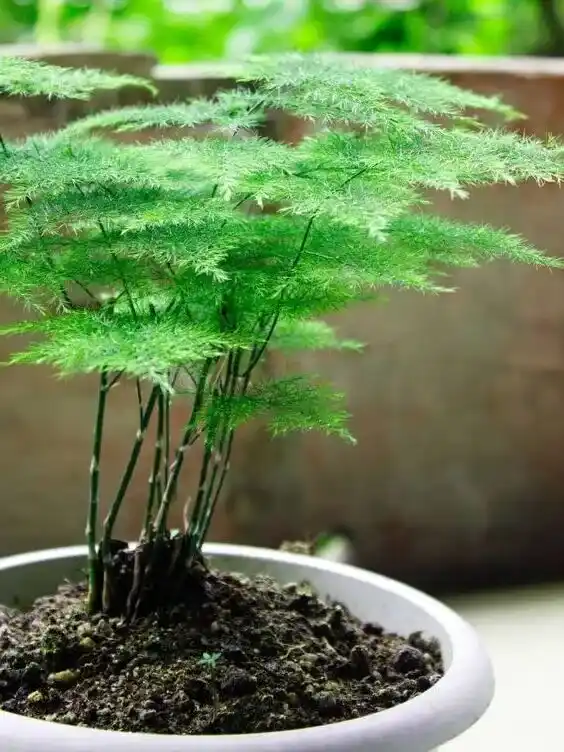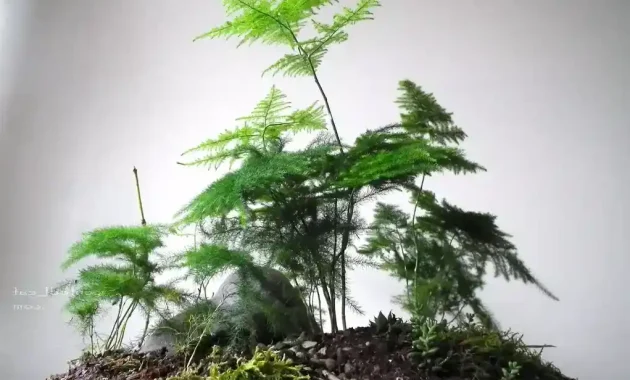Asparagus fern bonsai is a popular choice among bonsai enthusiasts, thanks to its delicate leaves and intricate branching structure. Growing and maintaining a thriving asparagus fern bonsai requires expert care tips and styling ideas to achieve its full potential.
In this article, you will learn everything you need to know about asparagus fern bonsai care, from selecting the right varieties to pruning and styling techniques. Our expert guidance will help you unlock the beauty of asparagus fern bonsai and create your own unique designs.
Whether you are a seasoned bonsai grower or a beginner, this article will provide valuable insights and tips to help you grow and maintain a healthy and beautiful asparagus fern bonsai.

Understanding Asparagus Fern Bonsai Care
Asparagus ferns are a popular choice among bonsai enthusiasts due to their delicate foliage and graceful demeanor. With proper care, they can thrive as stunning bonsai specimens. Understanding the essential care requirements for asparagus fern bonsai is crucial to maintaining their health and beauty.
Asparagus Fern Varieties Suitable for Bonsai Cultivation
There are several varieties of asparagus ferns suitable for bonsai cultivation, including the Asparagus densiflorus ‘Sprengeri’ and the Asparagus densiflorus ‘Meyersii.’ Both are known for their long, cascading foliage and make excellent choices for cascading or windswept bonsai styles. The Asparagus setaceus or ‘Asparagus fern’ is another popular variety for bonsai enthusiasts due to its striking foliage and fine texture.
How to Grow Asparagus Fern Bonsai
Asparagus fern bonsai thrives in a bright, indirect light environment. It is imperative to avoid direct sunlight as it can scorch the delicate foliage. Keep the soil consistently moist but not waterlogged, as overwatering can lead to root rot. Fertilize your asparagus fern bonsai every two to four weeks with a balanced fertilizer during the growing season.
Pruning Asparagus Fern Bonsai
Pruning is crucial to the overall health and beauty of your asparagus fern bonsai. Regular pruning promotes bushier growth and prevents the plant from becoming sparse. When trimming, avoid removing more than one-third of the plant’s foliage at once, as this can stress the plant.
When pruning, always use sharp, sterile pruning shears to avoid tearing the plant’s delicate foliage. Always cut back to a leaf node, as this will encourage new growth.
Asparagus Fern Bonsai Care Tips
- Asparagus fern bonsai prefers humidity levels of between 40% to 60%. You can increase the humidity around the plant by placing a tray of water nearby or misting the foliage regularly.
- Protect your asparagus fern bonsai from cold drafts and sudden temperature changes as they are sensitive to both.
- Regularly monitor your asparagus fern bonsai for signs of pests or diseases. Promptly address any issues to prevent them from spreading to other plants.
By following these essential care tips, you can maintain a healthy and beautiful asparagus fern bonsai for years to come.
[youtube width=630 height=350]eskIFRBJjrw[/youtube]
Potting and Soil Mixture for Asparagus Fern Bonsai
Proper potting and soil mixture are crucial for maintaining a healthy asparagus fern bonsai.
When it comes to choosing a pot, it’s important to consider the size of your bonsai. Ideally, the pot should be slightly larger than the root system to allow for growth. In terms of material, clay or ceramic pots are preferred due to their porous nature, which helps promote airflow and prevent waterlogging.
As for soil mixture, a well-draining and nutrient-rich composition is key. A mixture of peat moss, pine bark, and perlite is recommended for asparagus fern bonsai. The peat moss allows for water retention, while the pine bark and perlite provide adequate drainage.
When potting your asparagus fern bonsai, it’s important to ensure that the root system is spread evenly throughout the container. This can be achieved by adding soil mixture to the bottom of the pot, then gently placing the bonsai in the center and filling in with more soil mixture.
Once potted, the bonsai should be watered thoroughly to settle the soil mixture. However, it’s important to avoid overwatering, as this can lead to root rot and other issues. As a general rule of thumb, wait until the top layer of soil feels dry before watering again.
Pruning and Styling Asparagus Fern Bonsai
Asparagus fern bonsai can be styled and shaped in various ways to achieve different aesthetics. Pruning is an essential aspect of maintaining the overall health and appearance of the bonsai. It involves the removal of dead, damaged, or overgrown branches and foliage, allowing the bonsai to thrive and grow in its desired shape.
Pruning Techniques
When pruning asparagus fern bonsai, it is crucial to use sharp and clean tools to prevent damage or infection to the plant. Scissors and shears are perfect for trimming, while concave cutters are ideal for removing larger branches. The following are some common pruning techniques used for asparagus fern bonsai:
- Pinching: This technique involves the removal of the soft tips of the branches, forcing the plant to develop fuller foliage.
- Thinning: Thinning removes selected branches to allow more light and air to reach the interior of the plant, promoting healthy growth and development.
- Wiring: Wiring involves the careful bending and training of branches into a specific shape or style, using copper or aluminum wires.
Styling Techniques
Asparagus fern bonsai can be styled in various ways to achieve different visual effects. The following are some common styling techniques for asparagus fern bonsai:
- Formal Upright: This style involves a straight and upright trunk, with horizontal branches arranged symmetrically.
- Cascading: Cascading style features a trunk that grows vertically and then bends downwards along the container’s edge, creating a flowing waterfall effect.
- Windswept: This style mimics the effects of strong winds on a tree, with the branches all angled in one direction.
Expert Tip: When styling asparagus fern bonsai, it is essential to consider the plant’s natural growth pattern and adapt it to the desired style. It is also crucial to avoid over-styling and to allow the plant to grow and develop naturally.
Common Issues and Troubleshooting for Asparagus Fern Bonsai
Even with proper care, asparagus fern bonsai may experience some common issues that can affect their overall health and appearance. Here are some troubleshooting tips for dealing with these challenges:
Pest Infestations
Asparagus fern bonsai are prone to pest infestations, particularly spider mites and whiteflies. These pests can cause yellowing leaves and stunted growth. To prevent an infestation, regularly inspect your bonsai and remove any affected leaves or branches. You can also use insecticidal soap or neem oil sprays to control pests.
Yellowing Leaves
Yellowing leaves can be caused by various factors, such as overwatering, underwatering, or inadequate lighting. To remedy this, ensure that your bonsai is receiving the appropriate amount of water and light. Check the soil moisture regularly, and adjust your watering schedule as needed. If the yellowing persists, consider moving your bonsai to a spot that receives more light.
Root Problems
Root rot is a common issue that can be caused by overwatering or using a soil mixture that doesn’t drain well. To prevent root rot, ensure that the soil mixture you use is well-draining, and avoid overwatering your bonsai. If root rot has already set in, gently remove the affected roots and repot the bonsai in fresh soil.
Diseases
Asparagus fern bonsai can be susceptible to fungal diseases such as leaf spot and root rot. To prevent the spread of disease, remove any affected leaves or branches and improve the airflow around your bonsai. You can also use a fungicide to help control the disease.
Conclusion
Caring for asparagus fern bonsai can be a rewarding experience, but it does come with its challenges. By regularly inspecting your bonsai and addressing any issues as they arise, you can keep your bonsai healthy and thriving for years to come.
Unlocking the Beauty of Asparagus Fern Bonsai: Styling Ideas
Asparagus fern bonsai is a versatile plant that can be styled in various ways to achieve unique and aesthetically pleasing designs. The key to unlocking the beauty of asparagus fern bonsai through styling is to understand the different bonsai styles and how to incorporate them into your design.
Formal Upright Style
The formal upright style is the most common and traditional bonsai style, characterized by a straight and upright trunk with branches that gradually decrease in size from bottom to top. To style your asparagus fern bonsai in this manner, start by selecting a straight and tall trunk, and prune the branches accordingly to achieve the desired shape.
Cascading Style
The cascading style is a popular option for asparagus fern bonsai, as its foliage naturally cascades downward. Begin by selecting a trunk that cascades downward, and prune the branches accordingly to enhance the cascading effect. Place the bonsai in a hanging pot or cascade it down a shelf or table for added visual appeal.
Windswept Style
The windswept style is ideal for showcasing the graceful and delicate nature of asparagus fern bonsai. Start by selecting a tall trunk with multiple branches. Prune the branches so that they all face the same direction as if they are being swept by the wind. For added visual appeal, consider using wire to bend the branches slightly in the direction of the wind.
Experiment with these and other bonsai styles to find the perfect design for your asparagus fern bonsai. Remember to regularly prune and maintain your bonsai to ensure it remains healthy and thriving throughout its lifespan.


